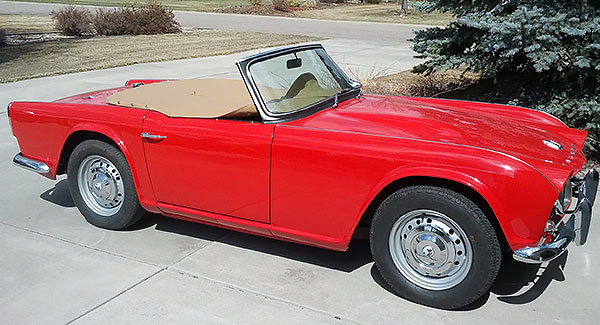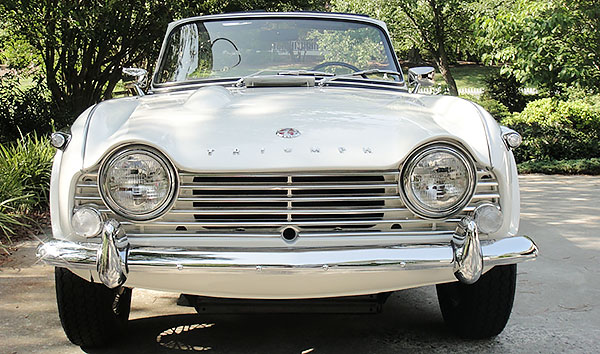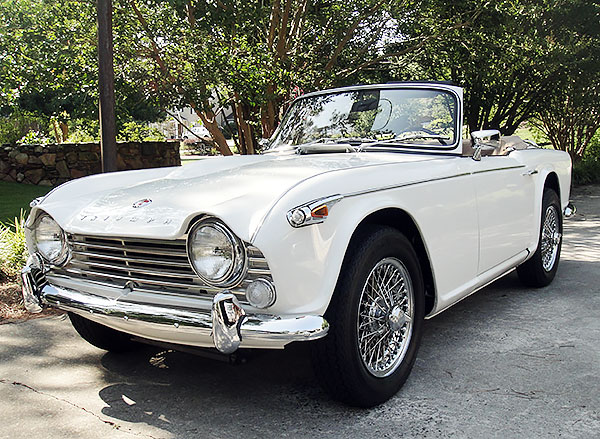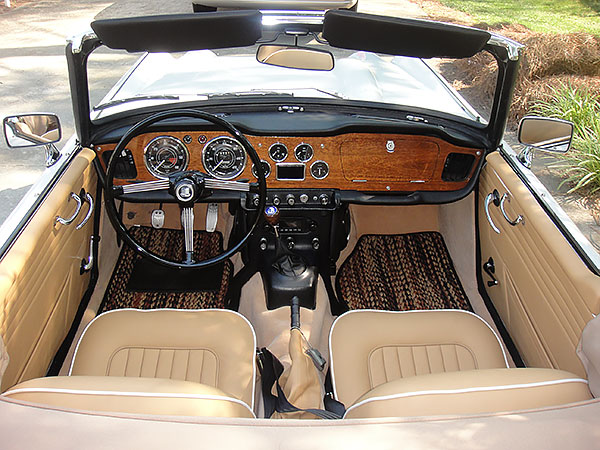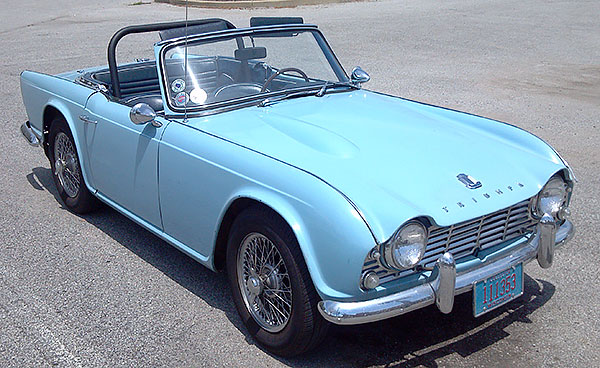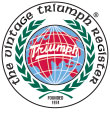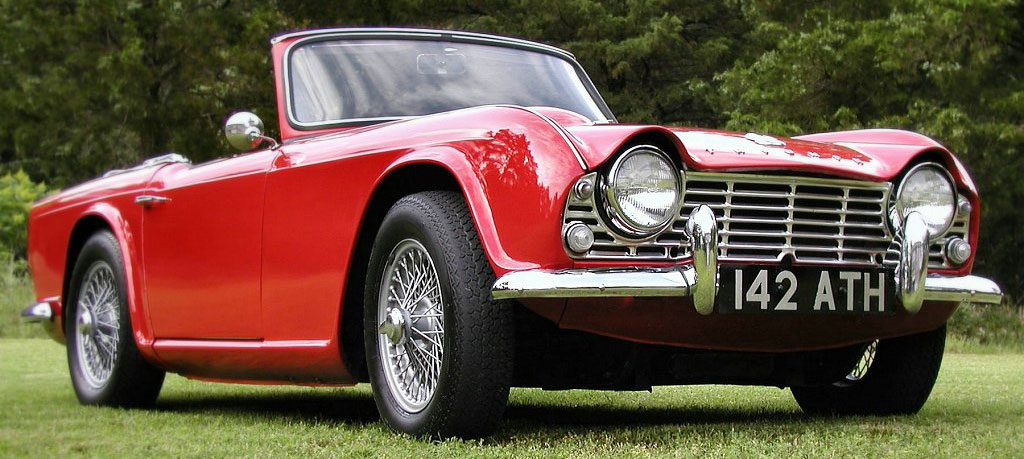
TR4
(1961-1965)
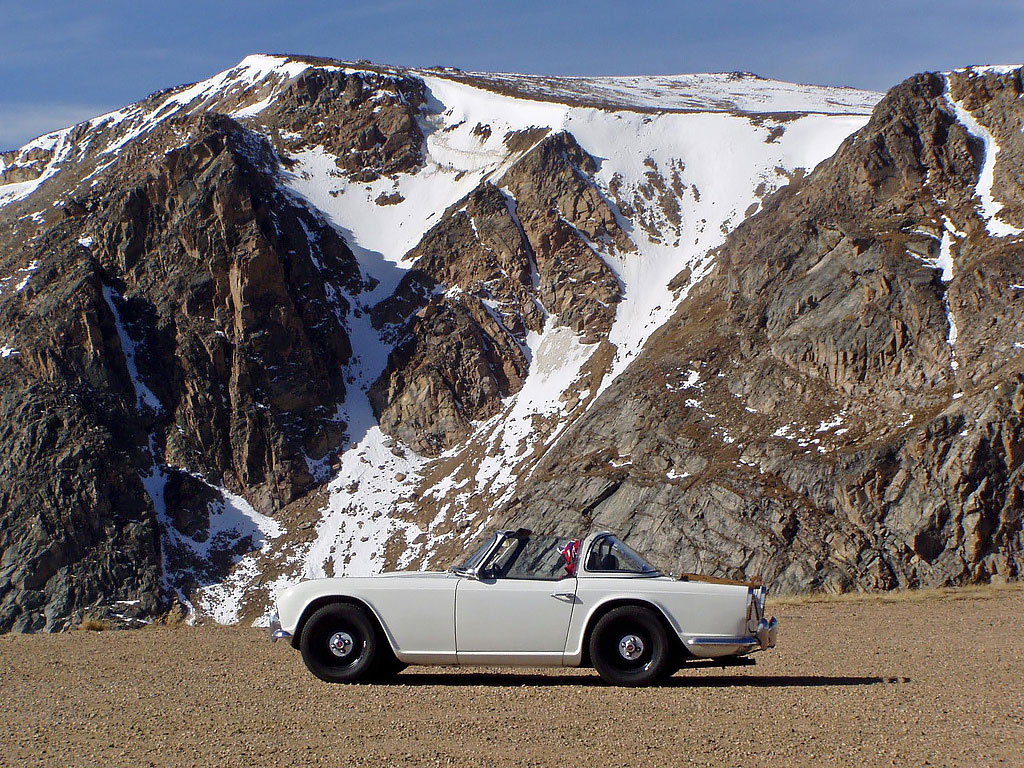
A Winner In Its Own Right
The success of the TR2 and TR3 models in the mid and late 1950’s made the Triumph Roadsters (TR) a viable product on the world’s stage. By the end of the 1950’s the Standard Triumph Motor Company was looking to the future with confidence in themselves and in the sports car market. It was at this point that they began to modernize and upgrade to their idea of what the future market would desire. Triumph, in 1961, began their transition to the six cylinder sports cars of later TR design – the TR250, TR5 , and TR6 . The TR4 has been called a transition between the TR2/3 and the TR6, but many auto critics of the time and most TR4 owners consider the TR4 a winner in its own right.
A Historical Overview of the TR4
by Arthur Kelly, ArthurK101@aol.com
VTR TR4 Vehicle Consultant
Introduction
During the 1950’s The Standard Triumph Company became a definite winner in the Sports Car market. By 1960, over 65,000 TR2/3’s had been sold. But changing tastes and a desire to upgrade their product led to a management decision to go for a new design. The Standard Triumph company’s intent was to upgrade their Triumph Roadster (TR) sports car so as to boost sales in what they saw as an increasingly competitive marketplace. To do this economically they would keep as much of the proven good features of the TR3 as possible and design a new, modern-looking body. The Italian auto designer Michelotti was approached for the project and agreed to take it on.
Michelotti’s task was to design a more modern sports car body which would fit the chassis and mechanical components of the TR3. The result was the TR4, which first rolled out of the Cranwell works at Coventry on July 18, 1961. Let us look first at the TR4’s body, which is the characteristic which most distinguishes it from the earlier TR’s. Then we’ll look at the chassis and mechanical components and their similarities and differences from the earlier TR’s.
- Body
- Interior
- Chassis & Suspension
- Engine / Transmission
- Brakes / Wheels
- Production Numbers
- Racing
- Conclusion
The body is what first distinguishes the TR4 from the earlier Triumph models (later TR bodies, through the TR6 , would continue to contain many aspects of Michelotti’s TR4 design). By the late ’50’s the idea of an open cockpit, low door, side curtained roadster was seen as out-dated. Entry into the European Common Market and changing tastes in the U.S. convinced the Triumph management to move to an open cockpit sports car with roll-up windows. Roll-up windows were not the only features which were considered desirable. The ventilation and heater system also needed to be fixed and the cockpit interior and luggage space needed to be enhanced. With these basic parameters in mind the Italian designer Michelotti came up with a wider, lower and more finely finished body than previous Triumph Roadster (TR) models. Bumper overriders were kept on the front bumper, but the headlights, parking lights and turn signals were all mounted in the grill. This opened the engine compartment by reducing the size of the front valence found on earlier TR’s. The hood (bonnet) was flattened out and hinged at the front. Since the body was now lower to the ground a hood bump was added to to allow for carburetor clearance. The fenders (wings) were flared out at the wheel wells to account for the new body’s wider track and the door handles were changed to a one-piece design with the lock built into the handle. Due to the fact that the doors contained roll-up windows the body line now continued parallel to the ground from the windscreen to the rear of the car. This allowed more space for luggage and spare tire stowage. The body exterior was uncluttered except for a TR4 badge on the hood, narrow stainless steel strips along the top (from the front of the hood to the windshield and then continuing from behind the cockpit to below the tail lights) and TR4 on the trunk lid. The letters TRIUMPH were also placed on the front of the hood and on the trunk lid. TR4 colors were shades of White, Black, Blue, Green and Red.
The body actually came in two versions although the company never capitalized on the fact that they were, in reality, offering a coupe as well as the roadster version. The first, and by far most popular version, was of course, the convertible (still called a roadster – although technically a roadster can not have roll-up windows). The Roadster version had a removable vinyl soft top with three plexiglass windows. The top was completely removed from the car and stored in the trunk when not in use. It was mounted on “hood sticks” which folded down into the rear of the cockpit and were then covered by a panel behind the seats. The convertible top was designed to be watertight by eliminating the front snaps which had held earlier TR model tops in place. The TR4 top had a metal strip inside the front edge. This strip was hooked into the top front of the windshield surround. When the top was installed and the roll-up windows were raised the design was effectively watertight (much more so than the earlier “side-curtains”).
For the TR4, Triumph offered an option called the “surrey top.” In reality, this made the convertible into a coupe. A permanent bolt-on metal section with a large rear window was fixed around the rear of the cockpit and a removable metal center section was placed over the seats. (Porsche and other auto-makers later used a similar design, calling it a “Targa top”). The “surrey top” removable section could not fit in the trunk, so a canvas section was provided in case one wanted to close up the cockpit when away from home. The “surrey top” was not popular at the time, probably because most people did not really understand what it was and Triumph did not market it correctly. (These are sought after today, maybe because we are familiar with “Targa’s” and “T-tops”).
The interior cockpit of the TR4 was roomier due to the new 4 inch wider body. In addition, the dash (fascia) had been moved forward which increased cockpit room from front to back. The dash was initially painted white with black vinyl padding along the top and bottom, but in the late ’63 or ’64 a highly polished mahogany veneered wood dash became standard equipment. (Because of the rich look, many early TR4’s have been retrofitted with wooden dashes). A deep, wide and lockable glove box (cubby) was provided on the passenger’s side of the dash. The tachometer and speedometer were positioned directly in front of the driver and gas, temperature, oil pressure, ammeter gauges (and an ashtray) were placed in the center of the dash. Also in the center underneath the dash was a lever connected to a vent scoop located on the outside in front of the windscreen. Opening this vent enabled fresh air to be drawn into the cockpit. Heat was provided by air passing through the heater located under the center of the dash. A fan then pushed the air either up onto the inner windshield or down to the floor. At the outer ends of the dash there were two square shaped vents which allowed unheated fresh air to be routed into the cockpit at chest level. This was a big improvement over the heating and venting systems of earlier TR’s.
Running vertically down from the center of the dash was a black metal plinth which was bolted to the cockpit floor. This strengthened the dash area and eliminated movement and rattling. The plinth also held the control knobs for various functions and was where the optional radio was installed.
The seats were initially the same seats as the in TR3 although the seat design was changed two more times before the TR4 was replaced in 1965. The seats were vinyl or optional leather in a choice of several colors. The doors, and the surrounding sides and rear of the cockpit, were covered in vinyl panels which matched the color of the seats. The doors also included map pockets and, as mentoned above, the 4 inch wider body resulted in more lateral room for the occupants.
The floor of the cockpit was covered forward of the seats with a ribbed black rubber mat held in place by snaps on the floor and clips on the inside firewall. From the front of the seats backward the floor was covered with charcoal-grey loop pile carpet. (This was the only carpet color available.) The transmission tunnel between the seats was carpeted fiberboard with the shifter handle coming through a ribbed rubber boot. A chromed hand-brake lever was installed on the right side of the transmission tunnel.
What Triumph now had was a modern looking, sleekly designed sports car with slightly better handling than earlier TR’s. This better handling was the result of the weight distribution and changes to the chassis, suspension, steering.
Although the basic frame (chassis) was the same as the TR3, several minor chassis modifications were made to accomodate Michelotti’s new body design. To accomodate the wider and heavier new body, the TR3 track needed to be widened by about 4 inches. This was done by welding a 2 inch long channel section on each of the TR3’s front box section chassis rails and extending the length of the rear axle (a two piece rigid axle) by 3 inches. This gave a wider track and a sleeker look – optional wire wheels could add another 1 inch of width. Body mounts were welded onto the extreme front of each chassis rail to eliminate body flexing. Rack and pinion steering, a definite plus, was added and although the front suspension members and steering geometry remained the same, the rear shock absorber mounts were reinforced because of the added body weight (about 70 lbs). The front suspension had wishbone arms with tubular shock absorbers inside helical coil springs. The rear suspension consisted of semi-eliptical leaf springs and lever action shock absorbers mounted on either side of the frame. Because
The engine used was a larger 2138cc Standard engine with 86mm pistons in “wet liners.” (The older 1991cc engine with 83mm pistons was still available if one wanted to race in the 2 liter class, although not many were installed). Use of “wet liners” means that the aluminum pistons rode inside cylinders of nickel-chrome iron. These cylinders were inserted into the block with the head gasket at the top and a “figure 8” gasket configuration at the bottom. The coolant could then flow, inside the block, all around the cylinders. In addition, the pistons and cylinders could be completely replaced without reboring the block. Compression for the new 2138cc engine was 9:1 with a horsepower rating of 105bhp and 128 lb-ft of torque. This increase in compression and horsepower insured that the TR4’s extra body weight (70lbs) did not result in decreased performance. Road and Track magazine reported in ’62 that the TR4 would go from 0 to 60 mph in 10.1 seconds with a standing quarter mile time of 17.5 sec at 77.2 mph.
The valve (rocker) cover was chromed steel with the oil filler cap at the firewall end. This gave a nice look when the hood (bonnet) was open. Carburretors were SU’s in the beginning and later changed to Zenith Strombergs. The later Zenith carbs had a “Y” shaped breather mechanism which routed crankcase gases from the valve cover to the air filters.
The cooling system was taken from the earlier TR’s and consisted of the radiator, a belt driven water pump and a cockpit heater. But on the TR4 the heater could be controlled from inside the car, a modern innovation for the time. The cooling system had two draincocks, one at the bottom of the radiator and the other at the lower right side of the engine block. This made changing the coolant rather simple. A four blade fan was installed at the front of the crankshaft and balanced to dampen crankshaft vibration. A skirted thermostat was installed so as to allow some coolant to bypass the radiator until the engine reached operating temperature.
The exhaust system was modified from the later TR3’s only as far as bracketry and mountings and consisted of a manifold, two silencers and a single tailpipe. This gave a muted, throaty sound to the TR4.
The transmission was similar to the earlier 4 speed TR transmissions except that it had synchromensh in all four gears. This meant that the days of double clutching to get into first gear were gone. An optional overdrive for 2,3,and 4th gear was also available.
The brakes were the same as the later TR3A’s – disc front and drum rear. This configuration was not standard on that many cars of the era and gave relatively good stopping power. In ’62, the second year of TR4 production, the front discs and calipers were modified to further increase braking efficiency. Along with the braking system the standard TR4 disk wheels and tires were the same as the earlier cars. Standard equipment consisted of 4 1/2 inch disc wheels with the Triumph globe in the center. The disc wheels were painted “silver lacquer” or “aluminum” colors, although some later wheels were painted body color, and some late TR4 disc wheels were painted white (either Spa or New). [ See Triumph Service Bulletin S-62-48 ]. Early TR4’s could be fitted with optional 4 inch wide wire wheels with 48 spokes – these were barely adequate and soon changed to 4 1/2 inch wide wire wheels with 60 spokes. The wire wheels were offered in silver or aluminum lacquer, or chromed (dull or bright) versions. All wire wheel configurations were fitted with chromed two-eared “knockoff’s” although some export markets (e.g. Germany) were fitted with octagonal “safety” knockoffs.
The TR4 was given Commission Numbers beginning with CT1 which was built on July 18,1961. The numbers continued in sequence until the final TR4, CT40304, which rolled off the line on Jan 6,1965. Approximate numbers for each year of TR4 production show that 2,470 cars were produced in ’61, 15,933 in ’62, 10,082 in ’63, 11,518 in ’64 and 250 in ’65. (Bill Piggott’s book Original Triumph TR gives more details on production and numbering). A copy of each car’s “build record” can also be had from the British Motor Industry Heritage Trust in the UK.
Worth mentioning is the fact that the TR4 was extensively raced under company sponsorship. In Europe the facory itself provided “works racers” and in America an organization called Group 44 raced modified TR4’s at Sebring and other race courses. The TR4’s did very well in racing form and today there are still many TR4’s to be found at Vintage Auto Racing Association (VARA) events in the U.S. In the 1960’s many TR4’s were involved in racing at LeMans and other European races. Both Auto Xrossing and Road rallying were, and are, other popular sports where one found and still finds TR4’s in attendance.
The success of the TR2 and TR3 models in the mid and late 1950’s made the Triumph Roadsters (TR) a viable product on the world’s stage. By the end of the 1950’s the Standard Triumph Motor Company was looking to the future with confidence in themselves and in the sports car market. It was at this point that they began to modernize and upgrade to their idea of what the future market would desire. Triumph, in 1961, began their transition to the six cylinder sports cars of later TR design – the TR250, TR5 , and TR6 . The TR4 has been called a transition between the TR2/3 and the TR6, but many auto critics of the time and most TR4 owners consider the TR4 a winner in its own right.
Above information provided courtesy of Arthur Kelly, Vintage Triumph Register TR4 Consultant
Member Pages
Bob Beers (Vila) | (Mechanicsburg, PA)
If you would like your page added to this listing, please contact the webmaster.
Production Dates and Numbers
by Arthur Kelly, ArthurK101@aol.com
VTR TR4 Vehicle Consultant
This part of the TR4 site will cover the build dates and corresponding commission numbers for the production run of the Triumph TR4. There are several important facts to keep in mind about the commission and other numbers. (See also the TR4 History section).
- TR4’s were numbered sequentially as they were built. The first TR4 (built Jul 18, ’61) had the commission number CT1 and the last TR4 (built Jan 6, ’65) had the commission number CT 40304. Present-day Triumph enthusiasts agree that the “model year” is the year in which the car was built – no matter what the license or title says. The reason that some cars show a later year on the title is because the car was not sold until a later time and was not titled by the dealer until it was sold. (Some importers also added another small plate (STC nn) for the year in which the car was sold/titled).
- Commission, Body, and Engine Numbers – Each car had at least three important numbers:
The Commission Number (CT nnnnnn) – found on the left side of the engine compartment on a plate in front of the firewall. This plate also gives other information such as whether the car was left-hand drive (L after the number), whether Overdrive was fitted (O after the number), and states the gross laden weight in pounds. Beginning sometime in 1963, the commission plate also carried codes for paint and interior colors.
The Body Number (nnnnnCT) – found in the engine compartment on the right side in front of the firewall. This plate is smaller than the commission number plate and contains only the body number. Since the bodies and chassis were built separately, the body and commission numbers will probably not match but are usually within a hundred or so of each other.
The Engine Number (CTnnnnnE) – found on the left side of the cylinder block (near the coil). The engine number usually does not match the other numbers because some Triumph engines were built and then sold to Morgan and other car makers. Therefore, the sequence of engine numbers was interrupted and does not match the commission / body numbers.
- Build Dates and Commission Numbers – the table below shows the approximate build dates and commission numbers for the Triumph TR4 model run. These the numbers were obtained from Original Triumph TR by Bill Piggott (1991, Bay Books Ltd) and other sources. (There are lists of numbers in after-market parts suppliers’ catalogues. If a number listed in one of those catalogues is near one of the year points listed in the table below, that number will need to be checked for accuracy.) The actual build date of any individul car can be obtained from The British Motor Industry Heritage Trust (BMIHT) in the UK. The table below shows the first commission number for each year of the TR4 run.
| Date Built | Commission Number | Remarks |
| Jul 7, 1961 | CT 1 | First production TR4 |
| Jan 1, 1962 | CT 2649 | |
| Jan 1963 | CT 18605 | Not verifiable as record is unavailable |
| Jan 1, 1964 | CT 28709 | |
| Jan 1, 1965 | CT 40193 | |
| Jan 6, 1965 | CT 40304 | Last production TR4 |
- The commission number of each TR4 is important for purposes of originality. The reason for this is that the changes made to brakes, dashboards (fascia panels), and other components are on record and provide the details needed for replacement/restoration work on the vehicle.
- The information given above is only part of the complete details available for the TR4. For answers to other questions regarding components, colors, and correct original equipment etc. please send an e-mail to ArthurK101@aol.com
Above information provided courtesy of Arthur Kelly, Vintage Triumph Register TR4 Consultant
